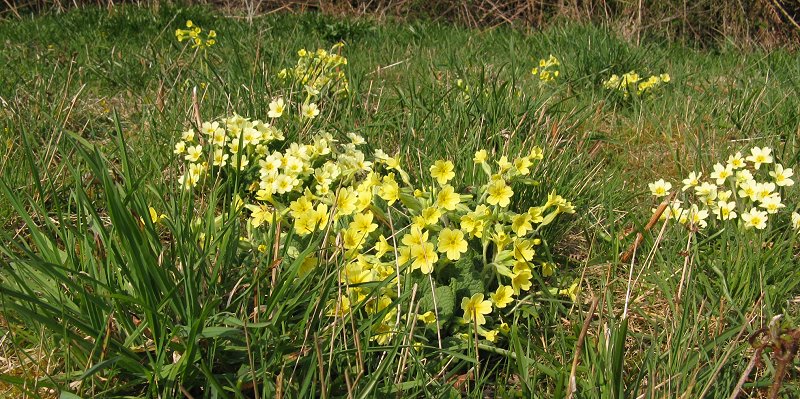
Back to the Index page
(Species lists below)

13 members attended this first outdoor meeting of 2018, on a lovely sunny day – a great relief after the long cold, wet spell earlier in the month. Chafer Wood is a YWT reserve in Netherby Dale just north of Ebberston village, east of Pickering. Although it is now mostly wooded with a couple of limestone grassland clearings, this steep-sided valley was previously rough grassland although I suspect originally at least the steeper slopes would have been native woodland (on my 1960s OS map it is marked as rough pasture with the exception of one tiny piece of wood). This land use history may account for the slightly odd mix of plants we saw (for instance the relative scarcity or absence of woodland species such as wood anemone, wood sorrel, bluebell and ramsons but the presence of several garden plants). The valley is cut into limestone and is usually dry, although after the rain there was a small stream running down it. Towards the northern end there is a more acid, sandy area at the top of the slope.
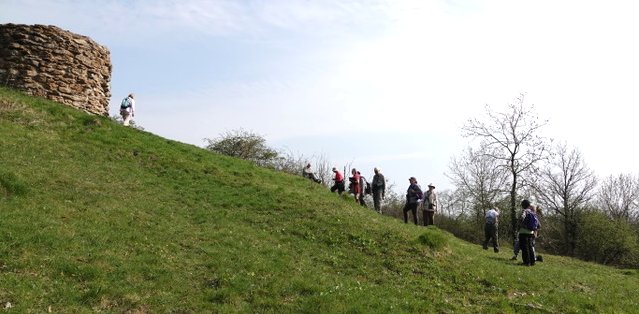
We walked up from the southern end, past an area that contains a variety of plants which are presumably garden throwouts, including several plants of stinking hellebore which have been known at this site for many years, but also snowdrops, garden daffodils and Welsh poppies. There are also native wood edge plants here such as dog violet and goldilocks buttercups, though strangely I did not see any early dog violets. We then spent a considerable time exploring the limestone grassland that leads up to a curious stone tower, which is a monument known as King Alfred’s Cairn, built in 1790 to commemorate “the place where Aelfred king of Northumbria rested after his defeat in 705” according to the notice inside. While this is probably a legend rather than fact, archaeological excavations in the 1950s in a cave in the hillside underneath discovered human remains dating back to Neolithic times.
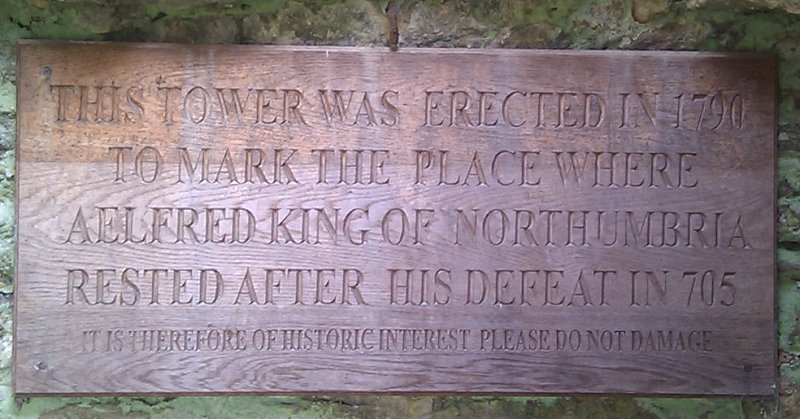
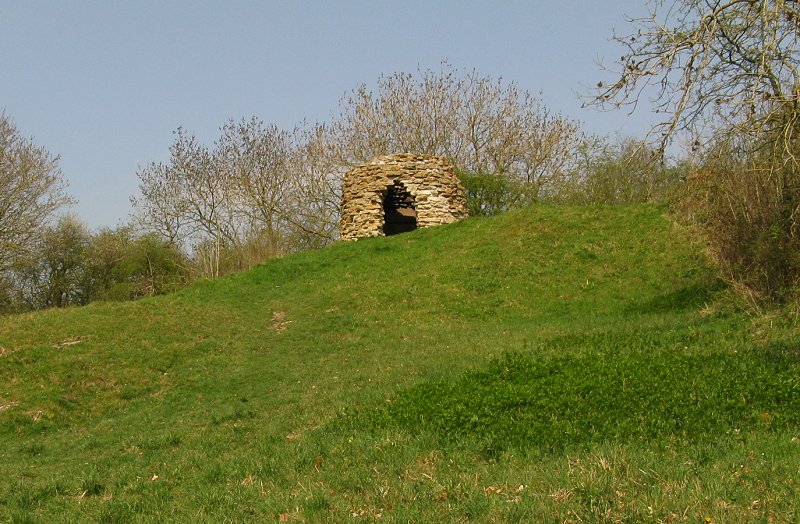
This area of grassland contains many interestng plants, including sweet and dog violets, and a patch of what appears to be the hybrid between sweet and hairy violets. We were too early for many of the flowers here, but we did spot leaves of woolly thistle, hoary plantain, salad burnet, lady’s bedstraw, mouse-ear hawkweed and several other species including grasses that cannot easily be identified until they flower. A repeat visit in early summer would be well worthwhile. Celandine and primulas including false oxlips were already in bloom, and attracting bumble-bees and bee-flies. The bee-fly is an interesting insect that is actually parasitic on bumble-bees, mainly the burrowing Andrena species I believe. While the botanists were exploring, those interested in the birds were delighted to hear some spring migrants such as willow warbler and blackcap singing.
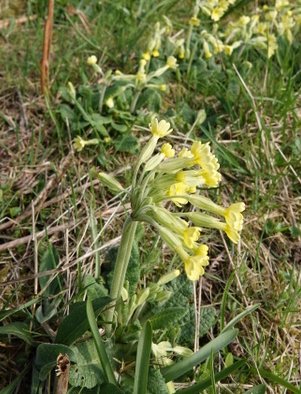 | 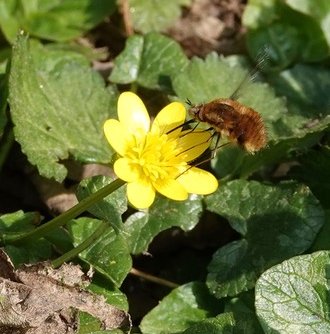 False oxlips Primula x polyantha (left) Bee-fly Bombylius major on celandine (above) |
We then walked up through the wood along the western edge of the reserve where we saw one or two old, very large logs of ash on which there were fine specimens of the fungus known as King Alfred’s Cakes – rather appropriate in view of the monument even if it is the wrong Alfred! You can see them as small purplish-black masses near the sawn end of the log. As they dry out they turn hard and black, just like a lump of charcoal or a very burnt bun. At one point beside the path we came across quite a sizeable patch of field garlic Allium oleraceum, not in flower yet but with plenty of chives-like garlic-smelling leaves. Like the hellebore this has been known at this location for many years, but how it got there and whether it has been helped to thrive I do not know.
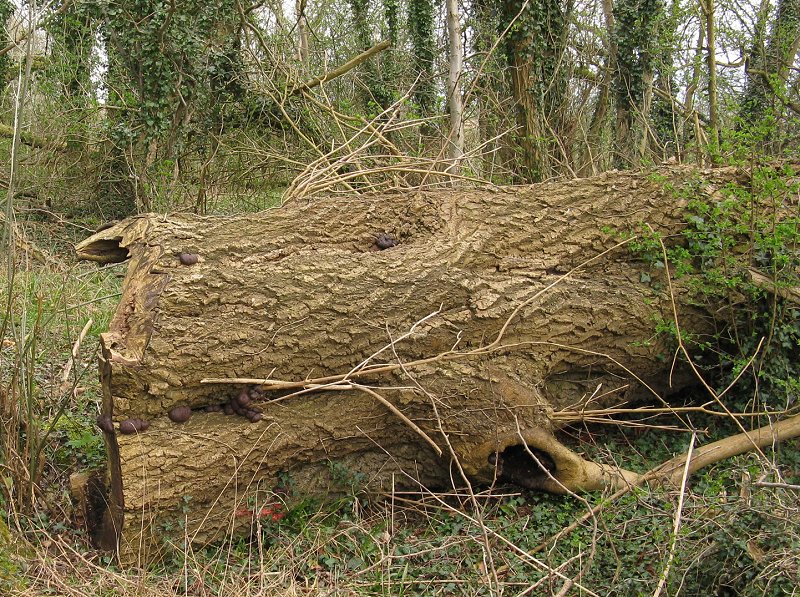
We then emerged into a second grassy clearing / piece of remnant limestone grassland, which was particularly notable for a wonderful show of primroses, cowslips, and every intermediate hybrid between them (see the picture at the top of the page). The management of this area requires constant cutting of encroaching thorn scrub, which would shade out this wonderful meadow. After a leisurely stroll round we returned to the bottom of the valley (though one or two keen birders carried on towards the northern end of the reserve first).
Back near the entrance we made a brief diversion to investigate the marshy area where the beck pours out of the rock face in a series of springs, marked on the map as “Petrifying Springs” as they deposit tufa, a form of lime, on their stream-beds – not terrifying at all... We did spot various marsh plants here such as marsh valerian, but like the first clearing we were too early in the season. Gipsywort is recorded from this area but we could not find it. Another trip later in the year is clearly called for.
This will be an incomplete list of what grows here, and includes several species identified only by their leaves (or in the case of some of the trees, buds).
| Latin name | Common name |
|---|---|
| Acer pseudoplatanus | Sycamore |
| Achillea millefolium | Yarrow |
| Aegopodium podagraria | Ground elder |
| Aesculus hippocastanum | Horse chestnut |
| Agrimonia eupatoria | Common agrimony(?) |
| Allium oleraceum | Field garlic |
| Anthriscus sylvestris | Cow parsley |
| Aquilegia vulgaris | Columbine (probably garden escape) |
| Arctium minus | Burdock |
| Arum maculatum | Cuckoo pint |
| Bellis perennis | Daisy |
| Betula sp. | Birch sp. |
| Brachypodium sylvaticum | Slender false brome |
| Caltha palustris | Marsh marigold |
| Cardamine flexuosa | Wavy bittercress |
| Cardamine hirsuta | Hairy bittercress |
| Carex flacca | Glaucous sedge |
| Centaurea nigra | Common knapweed |
| Cerastium arvense | Field mouse-ear |
| Chamaenerion angustifolium | Fireweed or Rosebay Willowherb |
| Circaea lutetiana | Enchanterís nightshade |
| Cirsium eriophorum | Woolly thistle |
| Conopodium majus | Pignut |
| Corylus avellana | Hazel |
| Crataegus monogyna | Hawthorn |
| Cruciata laevipes | Crosswort |
| Dactylis glomerata | Cocksfoot |
| Doronicum pardalianches | Leopardsbane |
| Dryopteris dilatata | Broad buckler fern |
| Dryopteris dilatata | Broad buckler fern |
| Equisetum palustre | Marsh horsetail |
| Fragaria vesca | Wild strawberry |
| Fraxinus excelsior | Ash |
| Galanthus nivalis | Snowdrop (garden escape) |
| Galium aparine | Cleavers |
| Galium verum | Ladyís bedstraw |
| Geranium robertianum | Herb Robert |
| Geum rivale | Water avens |
| Geum urbanum | Wood avens |
| Glechoma hederacea | Ground ivy |
| Helleborus foetidus | Stinking hellebore (garden escape but of long standing) |
| Helictotrichon pubescens | Downy oat-grass |
| Heracleum sphondylium | Hogweed |
| Holcus lanatus | Yorkshire fog |
| Hyacinthoides non-scripta | Bluebell |
| Ilex aquifolium | Holly |
| Juncus inflexus | Hard rush |
| Lonicera periclymenum | Honeysuckle |
| Lolium perenne | Perennial rye grass |
| Meconopsis cambrica | Welsh poppy |
| Mercurialis perennis | Dog's mercury |
| Myosotis sylvatica | Wood forgetmenot |
| Narcissus sp. | Daffodil (garden escape) |
| Pilosella officinarum | Mouse-ear hawkweed |
| Plantago lanceolata | Ribwort plantain |
| Plantago media | Hoary plantain (?) |
| Poa annua | Annual meadow-grass |
| Poa trivialis | Rough meadow-grass |
| Polystichum aculeatum | Hard Shield-fern |
| Potentilla reptans | Creeping cinquefoil |
| Potentilla sterilis | Barren strawberry |
| Primula veris | Cowslip |
| Primula vulgaris | Primrose |
| Primula x polyantha | False oxlip |
| Prunus avium | Wild cherry |
| Prunus spinosa | Blackthorn |
| Pteridium aquilinum | Bracken |
| Quercus sp. | Oak |
| Ranunculus auricomus | Goldilocks |
| Ranunculus ficaria = Ficaria verna | Lesser celandine |
| Ribes rubrum | Redcurrant |
| Ribes uva-crispa | Gooseberry |
| Rosa sp. | Rose |
| Rubus fruticosus | Bramble |
| Rubus idaeus | Raspberry |
| Rumex acetosa | Common sorrel |
| Rumex obtusifolius | Broad-leaved dock |
| Sambucus nigra | Elder |
| Sanguisorba minor = Poterium sanguisorba | Salad burnet |
| Senecio jacobea | Common ragwort |
| Silene dioica | Red campion |
| Stachys sylvatica | Hedge woundwort |
| Stellaria holostea | Greater stitchwort |
| Taraxacum sp. | Dandelion |
| Tilia sp. | Lime |
| Trifolium pratense | Red clover |
| Ulex europaeus | Gorse |
| Urtica dioica | Nettle |
| Valeriana dioica | Marsh valerian |
| Veronica chamaedrys | Germander speedwell |
| Veronica hederifolia | Ivy-leaved speedwell |
| Viola hirta | Hairy violet (?) |
| Viola odorata | Sweet violet |
| Viola riviniana | Dog violet |
| Viola x scabra | Hybrid violet (hairy x sweet) |
Thanks to Tom for this list:
Blue tit
Chaffinch
Herring Gull
Buzzard
Pheasant
Yellowhammer
Skylark
Mistle Thrush
Goldcrest
Blackcap
Blackbird
Coal tit
Rook
Wren
Goldfinch
Bullfinch
Robin
Redlegged partridge
Willow warbler
Nuthatch
Wood pigeon
Great tit
Jackdaw
Chiffchaff
Long tailed tit
Thanks to Melanie and Keith for this list:
Brimstone
Green Veined White
Peacock
Red-tailed bumble bee
Buff-tailed bumble bee
White tailed bumble bee
Carder bee
Bee-fly
Hairy-footed flower bee
King Alfred’s Cakes Daldinia concentrica
| © Ryedale Natural History Society 2018, Photos © Keith Gittens, Gill Smith 2018 |